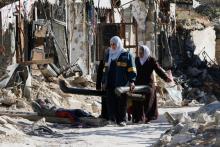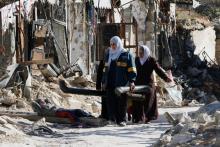For over a decade, Syria’s protracted conflict has taken countless lives, displaced millions in and outside the country and left much of its infrastructure in tatters. International mediation efforts to end the conflict have largely stalled, in part because the local dynamics that help fuel the crisis are often overlooked by formal mediators. This makes mediation efforts that seek to resolve inter- and intra-community conflict and address local concerns vital to advance formal peacemaking efforts led by national actors.
How Syrian women navigate security risks to mediate local conflicts
Syrian women have been instrumental in mediating various conflicts that have affected their communities. Most Syrian women mediators operate as ‘insider mediators’, meaning they have some connection to the dispute and are perceived as trustworthy and credible by the disputing parties. As insider mediators, women demonstrate two consistent strengths: the ability to build or leverage relationships, and the possession of detailed knowledge on the conflict and its parties.
Research from the region shows that conflict often changes socially-ascribed gender roles and enables women to take a more visible role in local mediation. This is particularly the case in Syria, where restrictions on men’s movement and the risk of arrest have created opportunities for women to engage in negotiations on critical issues ranging from service provision to ceasefires.
Negotiating ceasefires and brokering detainees’ release
Women in Syria have been involved in a number of mediation efforts related to sieges and ceasefires. For example, early in the war, as the northwest district of Zabadani, began to fall under the control of opposition forces, it was besieged by the government. The authorities demanded that men hand over weapons and surrender, which meant that only women could move safely across the lines of control. Though in pre-war Zabadani women were usually expected to focus on responsibilities inside the home, the restrictions and risks suddenly faced by men altered these dynamics and made it acceptable—and even necessary—for women to get involved in negotiations with government forces.
Quickly stepping into this newfound role, a group of women in Zabadani gathered and initiated a mediation process with the besieging forces in order to negotiate an end to the siege as well as a potential ceasefire. Prior to the siege, these women were not prominent figures in the community: “Most of these women became involved because their husbands were implicated with the opposition forces and were wanted by the government. The women themselves were mostly housewives and did not have any formal role in the community, but they gained their significance because they wanted to protect their husbands,” said Sameh Awad,* a peacebuilding expert familiar with the case.
The women were able to negotiate a ceasefire—successful in its early stages, though later collapsing due to the changing political context. Yet, for a period of time, “women were successful in ensuring civilians were protected and evacuated”, explained Awad.*
Women mediators often build informal coalitions with other women as a strategic way of strengthening their voice in negotiations. For example, after hearing a rumour that armed factions were planning to kill a group of detainees in the north-western city of Idlib, a group of female teachers worked to convince a wider group of women, including the detainees’ mothers, to approach the headquarters of the battalion leader. The encounter ended with the faction leader agreeing to speak with the military council and a month later, the detainees were released as part of an exchange deal.
Navigating security risks to access property and services
Many military-age Syrian men risk being conscripted upon return to areas under government control. As a result, women are more likely to return than men, and women and children often return first to settle housing, land and property and civil documentation claims, and to assess conditions and available services in the area. Upon return, they often must negotiate complex property claims as well as access to services.
Syrian women have also led mediation efforts with government forces to address security issues and service provision in areas formerly under opposition control. “The government insisted that men needed to complete military service, and this made many young men afraid to emerge in the public sphere,” explained Awad*. “So, women were involved in going out and exploring to what extent the discussions with the new authorities in the area were possible. During these negotiations, they discussed early recovery in their areas.”
One example of this type of mediation occurred in the district of Al-Kiswah, south of Damascus. After Al-Kiswah was returned to the control of the government, women engaged very discreetly in mediation with government authorities. Like in Zabadani, many men could not venture out of their homes without risking arrest, which pushed women into the role of negotiator: “On behalf of their communities, women reached out to political parties to create an entry point to get services, and then they took on the role of negotiating service provision, purchase of harvest, fertilizers to be used during the next harvest, opening the local school, and repairing the local medicine dispensary,” said Awad*.
These women’s efforts were particularly vital since areas such as al-Kiswah initially received very little external support. Humanitarian assistance was extremely limited, and there were no government services available. In this difficult context, “women played an important role in normalizing life in these areas—this was a civil society space that was not ‘NGO-ized’ or funded by donors, it was driven by survival. These actors emerged out of necessity because they wanted their communities to survive,” said Awad.*
Repairing social cohesion
Several years after the start of the conflict, Mobaderoon, a women-led civil society organisation in Damascus, noted an increase in localized violence stemming from fractured social relations and resentment towards internally displaced Syrians (IDPs) who had arrived in the capital. To address this violence, the organisation formed local committees made up of community leaders, mukhtars, other influential community members such as teachers and civil society activists, and ordinary residents. They established neutral spaces where people could meet and discuss issues affecting their neighbourhoods, and where they could build their confidence and skills to address these issues.
After some time, the women-led organisation expanded its work to Tartus, a coastal city in western Syria, and partnered with another women-led organisation that enjoys strong community ties and presence in the area. Their approach changed somewhat: “They focused their efforts on some neighbourhoods that had received very high rates of IDPs from other governorates, and where the relationship between the IDP and host populations was tense and fractured,” said Farah Hasan*, a member of Mobaderoon. “Because of the war and the influx of IDPs there were no services, or not enough services. Local youth accused the IDPs of being responsible for the war because they originated from areas under opposition control, and they carried out violent attacks against IDPs in nearby camps.”
This violence was creating substantial instability in the area. To address it, the director of the Tartus organisation launched an initiative aimed at improving relations between the host community and IDPs and stopping attacks against the camp residents.
“She met with influential community members and local business actors to convince them that the IDP camp should be integrated as part of the community so that IDPs could participate in the local economy,” said Hasan*. “She also initiated regular social meetings between women IDPs and women from the host community around issues like cooking, in order to build trust between the two sides.”
Through ongoing negotiation with community leaders, business actors, women from the IDP and women from the host community, attitudes slowly changed and the targeted neighbourhoods in Tartus witnessed notable differences in the treatment of IDPs. IDPs also reported less harassment and violence from host community members, greater acceptance of their children in schools, and more economic opportunities.

